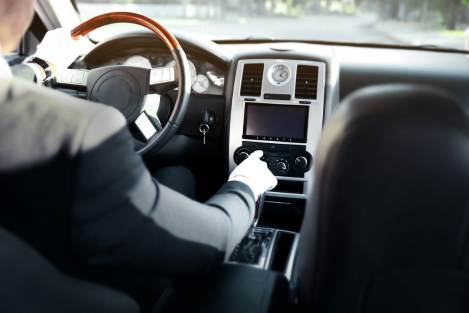Apr 4, 2024
Ontario Distracted Driving Laws, Fines, and Penalties for 2024

Distracted driving is one of the biggest issues on Ontario roadways today. It has surpassed impaired driving as the number one killer on the roads, and it is an issue that drivers need to take more seriously. 1 in 5 road fatalities are attributed to driving while distracted.
This is very concerning as distracted driving is preventable. If each driver were to do their part and be more dedicated to avoiding driving while distracted, countless accidents, injuries, and deaths could be prevented on Canadian roads.
Fines for partaking in this driving habit are now among the highest in Canada, and distracted driving can increase your insurance. Here’s what you need to know about the fines and laws for driving distracted.
Three main takeaways about distracted driving and insurance
- Distrcted driving continues to be one of the top risks for drivers.
- Penalties for distracted driving become more severe with each conviction.
- By detailing the penalties associated with distracted driving, drivers can prioritize safety and positive driving habits to contribute to safer roads.
What’s on this page
What is distracted driving?What are the distracted driving laws and rules in Ontario?
What is the definition of distracted driving?
What are the fines and penalties for distracted driving in Ontario?
What are the distracted driving penalties for novice drivers?
Is using a hands-free device considered distracted driving?
Ontario distracted driving statistics
Distracted driving statistics in Canada
Are there exceptions to the distracted driving laws?
What other ways are drivers distracted if they are not using their phones?
How does being distracted affect your driving?
Distracted driving could be considered careless or dangerous driving
What are the primary types of distracted driving?
11 tips to avoid distractions while driving
Distracted driving laws in other provinces
Ontario distracted driving FAQs
What is distracted driving?
Distracted driving is the act of driving while being distracted by other things or activities that take a driver's attention away from the road. Mobile phones, texting, eating, talking with other passengers, and changing the radio or GPS are common distractions.
Driving while distracted is dangerous because it increases the likelihood of an accident. It takes a driver's eyes and attention off the road and compromises the safety of the driver, passengers, other vehicles, and pedestrians.
What are the distracted driving laws and rules in Ontario?
The distracted driving laws in Ontario have changed over the past few years. According to the Ontario Ministry of Transportation, it is against the law to:
- Hold a phone or mobile device while driving.
- Operate handheld electronic devices while driving.
- View display screens that are unrelated to driving.
Cell phones are not the only devices restricted by Ontario's 2024 distracted driving laws. Here are some common handheld devices that you should NEVER use while driving:
- Infotainment systems
- iPod or music players (mp3)
- DVD (entertainment/video player)
- iPads & tablets
- Handheld video games
- Laptops
- GPS (unless it is mounted)
What is the definition of distracted driving?
To clear up any misunderstanding as to what is considered distracted driving and what is not, here is a distracted driving definition from the RCMP:
“Distracted driving is a form of impaired driving as a driver's judgment is compromised when they are not fully focused on the road. Distracted driving qualifies as talking on a cell phone, texting, reading (e.g., books, maps, and newspapers), using a GPS, watching videos or movies, eating/drinking, smoking, personal grooming, adjusting the radio/CD and playing extremely loud music. Even talking to passengers and driving while fatigued (mentally and/or physically) can be forms of distracted driving.”
According to Section 78 the Highway Traffic Act :
78. (1) No person shall drive a motor vehicle on a highway if the display screen of a television, computer or other devices in the motor vehicle is visible to the driver.
2. Part VI of the Act is amended by adding the following section :
Handheld devices prohibitedWireless communication devices
78.1 (1) No person shall drive a motor vehicle on a highway while holding or using a handheld wireless communication device or other prescribed device capable of receiving or transmitting telephone communications, electronic data, mail or text messages.
Entertainment devices(2) No person shall drive a motor vehicle on a highway while holding or using a handheld electronic entertainment device or other prescribed device, the primary use of which is unrelated to the safe operation of the motor vehicle. Hands-free mode allowed
(3) Despite subsections (1) and (2), a person may drive a motor vehicle on a highway while using a device described in those subsections in hands-free mode.
What are the fines and penalties for distracted driving in Ontario?
Distracted driving fines and penalties continue to change in Ontario. Drivers must know the repercussions of having a distracted driving charge on their record. Drivers can no longer get away with a warning if caught driving while distracted. You will be fined and subject to demerit points, increasing how much you pay for car insurance in Ontario.
| Distracted Driving Conviction | Fine | Demerit Points | Driver’s License Suspension |
|---|---|---|---|
| First conviction | Fine up to $1000 (minimum fine of $615 if settled out of court) | Three demerit points | Three-day suspension |
| Second conviction within 5 years | Fine up to $2000 | Six demerit points | Seven-day suspension |
| Third & subsequent convictions within 5 Years | Fine up to $3000 | Six demerit points | 30-day suspension |
What are the distracted driving penalties for novice drivers?
Novice drivers (G1, G2, M1, M2 licences) face the same fines and penalties as fully licensed drivers. You will not receive demerit points. You will face the following suspensions instead:
- First conviction: 30-day licence suspension.
- Second conviction: 90-day licence suspension.
- Third conviction: Cancellation of your licence and removal from the Graduated Licensing System.

Is using a hands-free device considered distracted driving?
Certain hands-free devices, such as GPS, hands-free phones, built-in display screens, and other tools, do not fall under the current distracted driving laws.
Here is a list the MTO provides for permitted hands free devices:
- A cell phone with an earpiece, headset or Bluetooth device using voice-activated dialling: Only to activate or deactivate a “hands-free” function, and only if the device is mounted or secured. Actions like dialling or scrolling through contacts are not allowed.
- A GPS screen: Provided the GPS is mounted on the dashboard or windshield. You must input the required information before you start driving.
- A portable media player plugged into the vehicle's sound system: But you must activate the playlist before driving.
- Display screens built into the vehicle and used for safety reasons.
- Ignition interlock devices.
Ontario distracted driving statistics
Here are some shocking statistics about distracted driving in the province:
- Ontario banned the use of hand-held electronic devices while driving, with a fine between $490 and $1,000, as well as demerit points as of June 2018.
- According to the OPP, distracted driving is Ontario's number 1 cause of accidents. It’s estimated that 8 in 10 accidents are caused by distraction.
- Deaths from collisions caused by distracted driving have doubled since 2000.
- One person is injured from a distracted driving-related accident every 30 minutes.
- There were 65 deaths in 2016, 83 in 2017, and 692 since 2009, according to the OPP. source).
- It is estimated distracted driving caused 7,435 accidents in Toronto alone in 2016.
Here are some statistics around distracted driving in Canada:
- Nearly 3 out of 4 Canadian drivers admit driving distracted. This means that the driver in front of you, behind you, and beside you has probably driven while distracted. Scary thought, right?
- Here is an even scarier one – you are 23 times more likely to crash if you engage in texting and driving.
- According to the MTO website, research demonstrates that “drivers who use cell phones are four times more likely to be in a collision than drivers who focus on the road. And when drivers take their eyes off the road for more than two seconds, their crash risk doubles.”
- Considering these distracted driving statistics, it’s not that surprising that the OPP recently reported that distracted driving is the number one killer on our roads, causing more deaths than impaired driving and speeding.
- It’s estimated that close to two-thirds (64%) of accidents result from a distracted driving action.
- Reaching for an object makes you nine times more likely to get into an accident.
- Distracted driving is a factor in 4 million car accidents in North America each year.
- Any road accident occurs an average of three seconds after a driver’s mind is taken off the road.
- 94% of teenagers understand the consequences of texting while driving, but 35% admit that they do it anyway.
- When polled, 77% of adults and 55% of teenage drivers say they can easily manage texting while driving.
- Distracted drivers fail to see up to 50% of the driving environment.
- 80% of collisions involved driver inattention up to 3 seconds prior, and 65% of near collisions.
- CAA polling showed 47% of Canadians admit that they have typed out or used the voice-memo feature to send a message while driving in 2021.
Are there exceptions to the distracted driving laws?
There are some exceptions and situations where safe cell phone use is permitted. You can call 911 in an emergency and use handheld devices when you are lawfully parked or have safely pulled off the road without impeding traffic.
The RCMP explains: “There are special circumstances under which it is safe to use a cellular device. If you see a hazardous driver swerving or driving erratically, safely pull over with your hazard lights and call 9-1-1. Gather as many details as you can, including the direction in which the car was going, the street, and the vehicle make and model. Knowing the license plate number can help too.”
Emergency personnel such as police, firefighters, and EMS can use cell phones while driving. “Commercial and public transit drivers, as well as public service workers who are engaged in the performance of their duties, will be able to view the display screens of mobile data terminals and logistical tracking and dispatching devices,” says MTO.
What other ways are drivers distracted if they are not using their phones?
There are plenty of ways people can get distracted while driving. Here’s a ranking of secondary behaviours among drivers and their frequency, as outlined in a recent IIHS study:
- Interacting with passenger: 11.7%
- Talking on cellphone: 6.5%
- Holding object other than cellphone: 5.6%
- Talking/singing/dancing alone: 4.9%
- Holding cellphone: 3.7%
- Smoking: 3.6%
- Adjusting radio/climate control or inserting/retrieving CD/cassette: 3.3%
- Eating: 2.8%
- Other cellphone interaction: 1.3%
How does being distracted affect your driving?
Distracted driving is dangerous because it takes your eyes and attention off the road. It only takes a second for something to happen, and you need to be prepared to react. Distracted driving can lead to:
- Less time to react
- Poor judgment
- Overreactions and making mistakes
- Injuring or killing yourself, your passengers and/or other people
Distracted driving could be considered careless or dangerous driving
Being convicted of distracted driving while putting others in danger could have even more severe consequences. MTO explains:
“Drivers who endanger others because of any distraction, including handheld and hands-free devices, may still be charged with Careless Driving under the Highway Traffic Act or even Dangerous Driving under the Criminal Code of Canada."
If you are convicted of careless driving as a result of distracted driving:
- 6 demerit points
- Fines of up to $2,000
- Jail term of six months
- Up to two-year licence suspension
Depending on the result of driving while distracted, you could also face dangerous driving charges, which is a criminal offence:
- Up to 10 years in jail for causing bodily harm
- Up to 14 years in jail for causing death
What are the primary types of distracted driving?
In general, driving distractions can be categorized into three types:
- Visual: Taking your eyes off the road – using a GPS, looking out the window, looking for something in the car.
- Manual: Removing hands from the wheel – holding your phone, eating, grooming.
- Cognitive: Not having your mind on driving – daydreaming, talking to passengers.
11 tips to avoid distractions while driving
Here are 11 great tips to stop being a distracted driver:
- Start by stowing your device: Since you know you can’t use it when driving, begin your travel by turning off your phone and putting it out of reach – such as in your glove compartment. If you’re unsure, you can resist the temptation to reach over and check.
- Review your route: Take some time to study any maps and directions you have before you set out to drive. “Figuring it out along the way” is not an effective strategy to avoid distracted driving. After your review, CAA suggests you put all reading material in your trunk.
- Pre-program GPS or playlist: If you have a global positioning system and know the address of your destination, program your GPS and determine your route beforehand. How is using a GPS not against the law if it’s a mobile device? As Section 78.1 of the Highway Traffic Act points out, a global positioning system navigation device is a specific exception. But programming your GPS while driving is against the law.
- Tidy up your vehicle: Remove anything not needed for your trip and secure any loose objects. Sliding objects when you turn a corner or brake firmly can be distracting, and dangerous.
- Preparation: Before you go, make sure children have everything they need at hand—reading materials, toys, food, and drink. And make sure you’re ready, too—including having all your grooming done before you get behind the wheel.
- Secure pets: If you don’t have a crate or a car barrier, consider purchasing a car harness or even a car seat to prevent your pet from jumping around in the vehicle. Keeping your pet restrained is important to both your safety and that of your pet.
- Pre-set climate control and radio: Before pulling out of the driveway, ensure that your radio pre-sets are selected and your climate control is set up.
- Make a passenger a co-pilot: If you’ve got a passenger beside you, allow them to help you focus on driving. This can range from assisting with directions to selecting music to opening beverages for you.
- Avoid eating and driving: While an open coffee or drink sitting next to you in a cup holder shouldn’t be much of a distraction, don’t eat or drink anything that requires you to open or unwrap it or otherwise distract you. Don’t even think of trying to eat that big and messy burger or ice cream cone while you’re behind the wheel.
- Concentrate: Scan the road, keep checking your mirrors, and keep two hands on the wheel. This will give you better control and reduce fatigue. Don’t let roadside activities, such as a yard sale or a sign-waving clown, distract you.
- Take breaks: As a general rule, you should stop at least every two hours to take a break from driving. Not only can you get the necessary fuel for yourself, your fellow passengers, and your vehicle, but the rest and movement can help you re-energize and refocus on the remainder of your trip.
Distracted driving laws in other provinces
Distracted driving laws in Canada vary from province to province. Currently, all 10 provinces and Northwest Territories have laws against distracted driving. Here are some interesting findings of the distracted driving laws in Canada:
- Distracted driving in Alberta has fines up to $1200.
- Nunavut is the only region in Canada with no distracted driving laws.
- First-time offence fines for distracted driving in Quebec are the lowest - $80-$100.
- The highest fines are in PEI – up to $1200.
- Manitoba and PEI have the most demerit points (5), with all other provinces having at least 3 demerit points.
Ontario distracted driving FAQs
Tens of thousands of auto accidents are caused by distracted driving in Ontario each year. An estimated 80% of all accidents result from driving while distracted.
In Ontario, distracted driving is responsible for 18% of all road fatalities. In 2022 alone, 105 Ontarians died as a result of distracted drivers, compared to 348 deaths across Canada.
Yes. Eating food while driving is considered distracted driving, but it is not illegal.
Drinking coffee while driving could be considered distracted driving if you cause an accident. It is not technically illegal.
How to stop distracted driving
You have a choice when you get behind the wheel. Make a smart choice and choose NOT to drive while distracted. Put the phone away, focus on the road, and keep car insurance more affordable.



